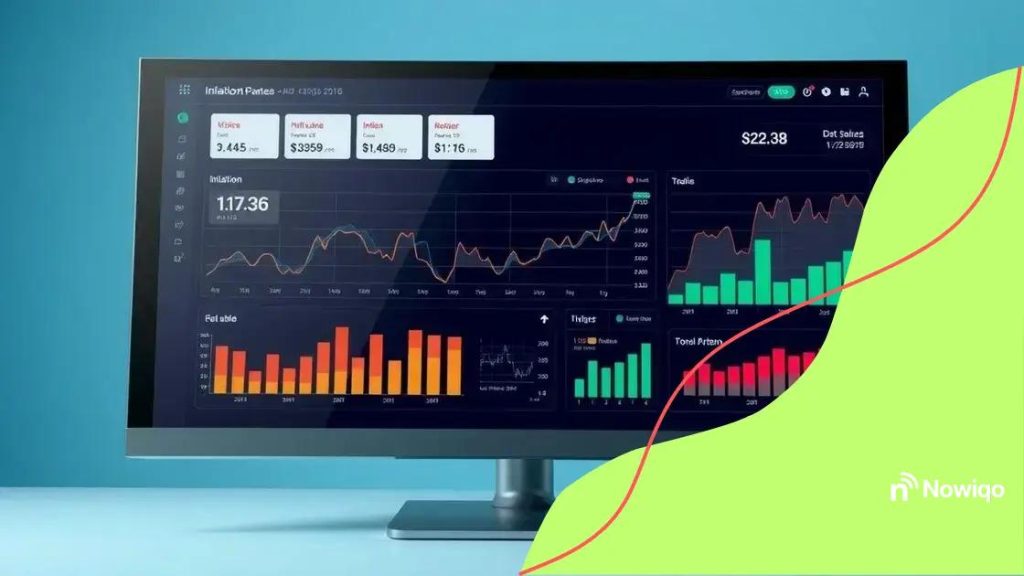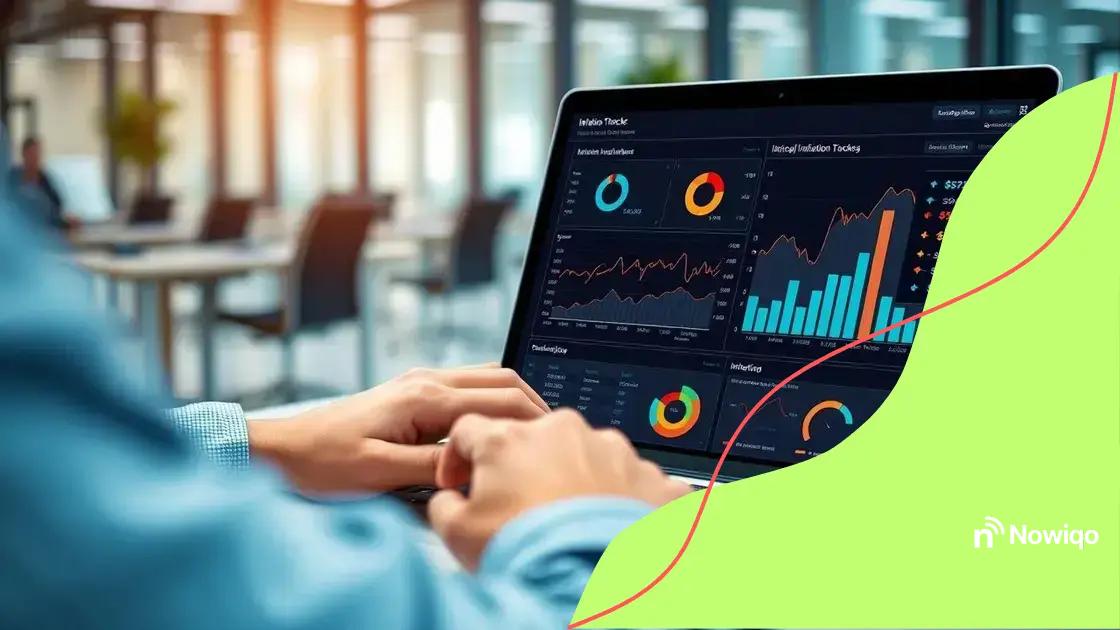Inflation tracker dashboard: Your key to financial awareness

Anúncios
An inflation tracker dashboard is an essential tool for monitoring inflation rates, providing real-time insights that help individuals adapt their financial strategies and maintain their purchasing power amidst economic changes.
Inflation tracker dashboard can be a game changer in how you manage your finances. Have you ever wondered how rising prices affect your budget? This article dives into the essentials of using these dashboards to stay informed and make smart financial decisions.
Anúncios
Understanding inflation: What it means for your wallet
Understanding inflation is crucial for making informed financial decisions. When we talk about inflation, we refer to the increase in prices over time, which affects your purchasing power. In simple terms, as prices rise, the same amount of money buys fewer goods and services. This shift in value can deeply impact your wallet.
How inflation impacts your finances
When you are aware of inflation, you can adjust your budgeting and spending habits accordingly. Keeping track of the inflation rate allows you to anticipate changes, so you are not caught off guard. It is essential to understand how inflation can affect different aspects of your financial life.
Key areas affected by inflation
- Cost of living: Daily expenses, such as groceries and transportation, become more expensive over time.
- Savings: The value of your money decreases, which can erode your savings if interest rates do not keep pace with inflation.
- Investments: Inflation can affect the performance of your investments, with some assets outperforming others in times of rising prices.
- Wages: If wages do not increase to match inflation, your purchasing power diminishes.
Being mindful of these areas helps you navigate financial uncertainty. For example, if you know inflation is rising, you might reconsider big purchases or evaluate your savings strategy. Investing wisely becomes incredibly important since you want your money to grow at a rate higher than inflation.
Anúncios
In summary, understanding inflation allows you to make proactive decisions about your finances. Whether it’s altering your budget, exploring investment opportunities, or simply learning to adapt your spending, the more you know, the better choices you can make. Keeping an eye on inflation trends will ultimately help you safeguard your wallet’s health.
The importance of an inflation tracker dashboard
The importance of an inflation tracker dashboard cannot be overstated. These tools offer valuable insights into economic changes, helping you manage your finances more effectively. With easy access to real-time data, you gain a clear perspective on how inflation impacts your spending and savings.
Benefits of using an inflation tracker dashboard
A dashboard provides essential tools to visualize and analyze inflation trends. You can make informed decisions about your money based on accurate data. This proactive approach allows you to adjust your financial strategies as necessary.
Key features of an effective inflation tracker
- Real-time updates: Stay informed about current inflation rates.
- Visual data representation: Graphs and charts make it easier to understand trends.
- Comparison tools: Assess different periods of inflation to spot patterns.
- Customized alerts: Receive notifications about significant changes in inflation.
By utilizing these features, you become more adept at navigating your personal finances. For instance, if you notice a rise in inflation, you might consider adjusting your budget to accommodate higher prices. This approach can safeguard your savings and ensure that your investments remain profitable amidst economic changes.
Moreover, having a dedicated inflation tracker dashboard helps you plan for the future. Understanding how inflation trends may evolve allows you to strategize long-term financial goals. Whether you are looking to save for retirement or simply manage your monthly expenses, these dashboards serve as a vital resource.
How to use an inflation tracker dashboard effectively

Learning how to use an inflation tracker dashboard effectively can empower your financial decisions. These dashboards provide interactive tools to help you monitor and analyze inflation data. By understanding the features and functions they offer, you can stay better informed about economic trends that may affect your wallet.
Getting started with your dashboard
Begin by familiarizing yourself with the layout and available features of the dashboard. Most dashboards offer customizable settings that allow you to choose what data to display. Tailoring the view to fit your needs helps you focus on the most relevant information.
Setting up alerts and notifications
- Customize alerts: Set notifications for significant changes in inflation rates that could impact your finances.
- Analyze historical data: Review past inflation trends to identify patterns and make informed predictions.
- Use comparison tools: Compare current inflation rates with previous periods to understand changes better.
These features can enhance your ability to respond to economic shifts proactively. For instance, if you receive an alert about rising inflation, you can prepare to adjust your spending or investment strategies. Additionally, understanding historical trends can help you make better predictions about future economic conditions.
Another tip is to regularly review the graphs and visualizations provided. Visual data representation helps you comprehend complex information quickly. You can see trends at a glance and identify any areas that may require your attention. Moreover, keeping a close watch on these visuals enables you to track your financial health over time.
Finally, integrate insights gained from the dashboard into your overall financial planning. Using the information effectively can lead to better budgeting and financial strategies, which can ultimately help you maintain or even grow your wealth.
Comparing popular inflation tracker tools available
Comparing popular inflation tracker tools available can help you choose the best option for your financial needs. Each tool offers unique features that cater to different user preferences. By understanding these differences, you can select a tracker that aligns with your goals.
Key features to consider
When evaluating inflation tracker tools, consider their ease of use, data accuracy, and visualization options. These elements greatly affect how well you can monitor inflation.
Popular inflation tracking tools
- Tool A: Offers real-time inflation updates and customized notifications that keep you informed.
- Tool B: Features comprehensive historical data analysis, allowing users to uncover trends over time.
- Tool C: Provides intuitive graphical representations, making it easier to interpret inflation data at a glance.
- Tool D: Includes social sharing options, enabling users to discuss findings with others.
Understanding these features helps you determine which tool best suits your financial strategy. For example, if real-time updates are critical for you, Tool A might be the right choice. Alternatively, if historical context matters more, Tool B could serve you better.
Another aspect to consider is the compatibility of the tool with other financial resources. Some trackers integrate seamlessly with budgeting apps, which can streamline your financial planning process. Tracking inflation and managing your budget concurrently can lead to better financial health.
Moreover, read user reviews and ratings to gain insight into each tool’s performance. Feedback from other users helps you gauge reliability and ease of use. Personal experiences can illuminate the strengths and weaknesses of each tracker, guiding your decision.
Future trends of inflation tracking technology
Future trends of inflation tracking technology are shaping the way we monitor economic changes. As technology evolves, so do the tools we use to analyze inflation data. This advancement will make tracking these economic indicators more accessible and efficient.
Integration of artificial intelligence
One major trend is the incorporation of artificial intelligence (AI) in inflation tracking tools. AI can analyze vast amounts of data quickly, providing real-time insights into inflation trends. This means that users will get more accurate and timely information about price changes, helping them make informed financial decisions.
Enhanced data visualization
Another important trend is the improvement in data visualization. Future dashboards will likely feature more sophisticated visual representations, allowing users to grasp complex inflation information at a glance. Interactive graphs and charts will enable users to explore data more comprehensively.
Mobile accessibility
- Mobile applications: Expect inflation trackers to become more user-friendly with mobile app versions.
- Real-time notifications: Users can receive alerts on their smartphones about significant inflation changes.
- Personalized dashboards: Future tools will offer customizable features for users, letting them tailor the interface to their needs.
The shift towards mobile accessibility means that people can monitor inflation trends wherever they are. This flexibility allows for a more hands-on approach to managing finances effectively.
In addition, the future of inflation tracking may see a rise in community-driven platforms. Users can share their insights about inflation trends, which can enhance the understanding of local economic conditions. By collaborating, users can benefit from a broader perspective on inflation impacts affecting their financial situations.
Overall, as inflation tracking technology improves, users will find themselves better equipped to navigate the economic landscape. Keeping up with these trends will be crucial for anyone aiming to manage their finances in an increasingly dynamic environment.
In conclusion, understanding inflation and utilizing effective tools for tracking it is essential for managing your finances. As inflation tracking technology evolves, features such as artificial intelligence, improved visualizations, and mobile access will provide users with better insights. By staying informed and using these advanced tools, you can make smarter financial decisions that protect your purchasing power. The future of inflation tracking looks promising, ensuring you are always equipped with the necessary information to navigate economic changes.
FAQ – Frequently Asked Questions about Inflation Tracker Dashboards
What is an inflation tracker dashboard?
An inflation tracker dashboard is a tool that helps users monitor and analyze inflation rates in real-time, providing valuable insights into economic changes.
How can I use an inflation tracker to manage my budget?
By keeping track of inflation trends, you can adjust your budget to account for rising prices, ensuring your purchasing power stays intact.
What features should I look for in an inflation tracking tool?
Look for features like real-time updates, data visualization options, customizable alerts, and compatibility with other financial tools.
Will inflation tracking technology improve in the future?
Yes, future trends include AI integration, enhanced data visualization, and better mobile accessibility, making it easier to track inflation.